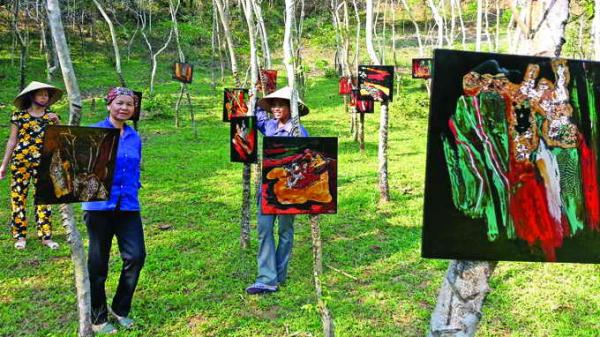An exhibit and presentation on lacquer paintings titled “Cham” (Touch), held in mid May, unprecedentedly took place in the forest, where resins are collected and made into lacquer.
The exhibit, initiated by artist Vo Xuan Huy, took place at Di Nau village in northern Phu Tho province’s Tam Nong district, which has been known for wax trees (rhus succedanea) and for resin collection activities that have been going on for hundreds of years.
The locals are thus no stranger to several-century-old wooden, lacquer-finished items which are plentiful at temples and pagodas within their village such as altars, horizontal lacquered boards (usually engraved with Chinese characters), worship wares and palanquins.
However, for most locals, it was their first time to personally see the paintings of modern art, which they can take pride in, given the striking artworks are made from the resin they collect every day.
“Cham”, which was a fuse of exhibition, installation and presentation, featured 25 lacquer paintings by Huy, with each tied to a wax plant.
“The wax plant is an integral part in lacquer making. Coming here I’m much more inspired to produce more works,” Huy shared.
“I’ve been to many exhibits, but this one, with the lacquer paintings displayed right in the wax forest, where the product materials come from, gives me such an interesting experience,” said Vo Dai Duong, a student from the Hue Arts University.
The farmers and art students gathered amidst the forest, listening intently to artist Vo Xuan Huy presenting on the several sophisticated phases of the lacquer producing process.
After several days, the collected resin settles into three different layers. The first two are made into lacquer paints while the lowest layer is used to make the ‘body’ of the painting.
The paints should be kept in airtight, humid rooms to accelerate the drying. Stropping the surface to give it high gloss and expose the hues beneath is also performed continuously between the phases, which gives the art its name ‘son mai’.
It thus takes at least six months to have a finished lacquer painting, with some phases subject to revision until they meet the artists’ satisfaction, Huy noted.
The farmers in turn gave presentations on various topics including characteristics of the wax plant, tree care-taking, resin collection and resin-allergy treatment.
Huy noted that based on the art ecosystem, Vietnamese lacquer paintings meet all criteria for sustainable development, including farming, resin collection, teaching, composing and exhibition.
However, in reality, the craft still lacks systematic development and interaction among those involved.




















































